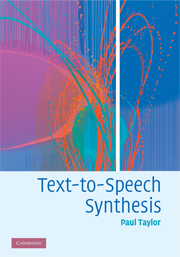Book contents
- Frontmatter
- Contents
- Foreword
- Preface
- 1 Introduction
- 2 Communication and language
- 3 The text-to-speech problem
- 4 Text segmentation and organisation
- 5 Text decoding: finding the words from the text
- 6 Prosody prediction from text
- 7 Phonetics and phonology
- 8 Pronunciation
- 9 Synthesis of prosody
- 10 Signals and filters
- 11 Acoustic models of speech production
- 12 Analysis of speech signals
- 13 Synthesis techniques based on vocal-tract models
- 14 Synthesis by concatenation and signal-processing modification
- 15 Hidden-Markov-model synthesis
- 16 Unit-selection synthesis
- 17 Further issues
- 18 Conclusion
- Appendix A Probability
- Appendix B Phone definitions
- References
- Index
18 - Conclusion
Published online by Cambridge University Press: 25 January 2011
- Frontmatter
- Contents
- Foreword
- Preface
- 1 Introduction
- 2 Communication and language
- 3 The text-to-speech problem
- 4 Text segmentation and organisation
- 5 Text decoding: finding the words from the text
- 6 Prosody prediction from text
- 7 Phonetics and phonology
- 8 Pronunciation
- 9 Synthesis of prosody
- 10 Signals and filters
- 11 Acoustic models of speech production
- 12 Analysis of speech signals
- 13 Synthesis techniques based on vocal-tract models
- 14 Synthesis by concatenation and signal-processing modification
- 15 Hidden-Markov-model synthesis
- 16 Unit-selection synthesis
- 17 Further issues
- 18 Conclusion
- Appendix A Probability
- Appendix B Phone definitions
- References
- Index
Summary
We finish with some general thoughts about the field of speech technology and linguistics and a discussion of future directions.
Speech technology and linguistics
A newcomer to TTS might expect that the relationship between speech technology and linguistics would parallel that between more-traditional types of engineering and physics. For example, in mechanical engineering, machines and engines are built on the basis of principles of dynamics, forces, energy and so on developed in classical physics. It should be clear to a reader with more experience in speech technology that this state of affairs does not hold between the engineering issues that we address in this book and the theoretical field of linguistics. How has this state of affairs come about and what is the relationship between the two fields?
It is widely acknowledged that researchers in the fields of speech technology and linguistics do not in general work together. This topic is often raised at conferences and is the subject of many a discussion panel or special session. Arguments are put forward to explain the lack of unity, all politely agree that we can learn more from each other, and then both communities go away and do their own thing just as before, such that the gap is even wider by the time the next conference comes around.
The first stated reason for this gap is the “aeroplanes don't flap their wings” argument.
- Type
- Chapter
- Information
- Text-to-Speech Synthesis , pp. 533 - 539Publisher: Cambridge University PressPrint publication year: 2009



